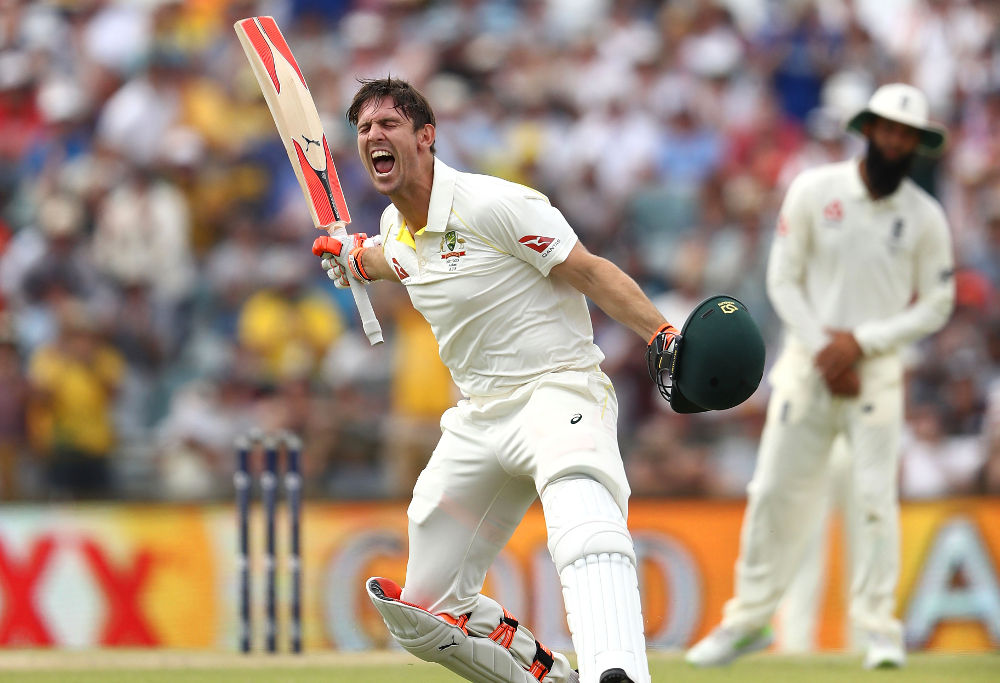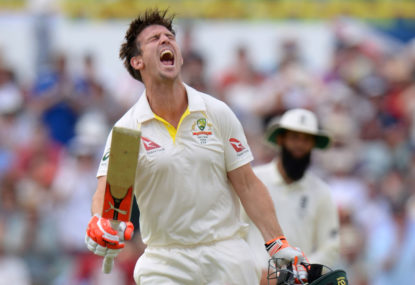Mitch Marsh had a pretty good Christmas and New Year period. Seemingly a long way from the Test squad when it was first announced, and still pretty long odds the day before he was eventually recalled, his picture now sits under the definition of ‘making every post a winner’.
I’ve said previously that Peter Handscomb was stiff losing his spot to Marsh ahead of the Perth Test, just as Glenn Maxwell was stiff losing his to Shaun Marsh. But to the brothers’ great credit, they’ve done precisely the job the selectors wanted them to do.
In Mitch’s case, while it’s also a long time coming, it also adds – or reintroduces – a really interesting chapter in the manual around building the Australian cricket team.
The selectors have hardly hidden the fact they’ve been looking for a genuine allrounder at No.6 for more than a decade, and Marsh suddenly looks to be the ‘one’ they hoped he could be when first picking him as a 23-year-old back in 2014.
Marsh was viewed as the logical replacement for the Shane Watson-type of player, and it’s become clear this summer that a batsman who bowls more-than-handy seamers is the preference. And that sort of makes sense; no matter what Maxwell might bring to the team, and no matter how illogical it is that neither coach nor captain rate his bowling, a 135km/h bowler is much more useful and offers more balance to this Australian side than does a second spin option.
Marsh’s 181 in Perth was a breakout innings. Though he made 87 and 47 in his second Test, his maiden Test century 20 matches later was confirmation that not only does he belong at this level, but that he can dominate it.
His innings took 236 balls all up – 234 given he only lasted two more balls on Day 4 and didn’t add to his score – which suggests that he went at a pretty fair clip. But there is more to this than just 181 off 236 balls; a deeper look at the breakdowns gives a glimpse of a new-found ability to change gear, and defend or accelerate as the situation dictates.
[latest_videos_strip category=”cricket” name=”Cricket”]
The breakdown reads thus: his first 50 from 74 balls; 100 from 130 balls (second 50 in 56 balls); 150 in 188 balls (third 50 in 58 balls), and 181 in 236 balls (last 31 in 48 balls).
On appearance, it looks as though he took his time to get ‘in’, but then put the foot down once he passed 50. But once again, there’s more to it.
The second 50 took 56 balls, but in truth, he was 59* from 90 balls at drinks in the middle session; that is, after bringing up his 50, he refocussed to get to the break and added just nine from 26 balls. He then took 18 from his next 11 balls after drinks, including 4 fours. Now set, he was starting to put the bad ball away, but then as he neared 87 – his highest Test score – he resettled, hitting just two boundaries in the next six overs.
Four-dot-four brought up his hundred, but within that second 50 in 56 balls were ten boundaries. The remaining ten runs to complete the hundred took 46 balls.
It was a similar story beyond 100. 58 balls for the third fifty, but with eight fours. His last 31 from 48 balls included another four boundaries. 116 of his 181 runs came from 29 boundaries, the remaining 65 from a comparatively patient 207 balls. This showed his next innings didn’t exactly come from nowhere.
The 166-ball second innings 29* in Melbourne helped salvage the draw for Australia, and much was made of the fact that Marsh put the fireworks from Perth away. In the context of his average Test innings lasting just over 40 balls, 29* from 166 was arguably just as important as what had felt like a run-a-ball in Perth the week before. But now that we know about the other 65 in Perth, and the sweet time he took to get them, that Melbourne innings doesn’t look so unusual.

Photo by Ryan Pierse/Getty Images
Marsh has always been able to score quickly, but here lies some decent proof that he’s also more than capable of grinding out an innings. Considering what he’d done in his Test career to this point – two 50s in 35 innings, lasting around 42 balls per innings on average – this was a huge turnaround.
Come Sydney, his 141-ball 101 was closer to the Marsh we thought we know, but still with that important element of patience early on.
In finishing 63* on Day 3, Marsh’s 87-ball knock again showed this impressive ability to change gears: his first 30 balls yielded just three runs; the next 30 were thumped for 45, as he quickly closed in on another Test 50, before passing the milestone and settling down before stumps with 15 off the remaining 27 balls.
The next morning, Marsh reset and worked well with brother Shaun to build a match-winning stand. He took 38 balls to move his score to 78, before putting the foot down again running into drinks. Consecutive boundaries either side of seven dot balls and a couple of twos saw him to 99.
Shaun saw out the first over after drinks, Mitch guided one through point to bring up the ton, and was then bowled by Tom Curran next ball, to one that cut back on him a fair way.
101 from 141 balls, but 38 from 54 balls to ensure the Australian side got going again on the fourth day. It was exactly the sort of innings you want from your number six; the perfect mix of comfortable consolidation and rampant attack.
South Africa in South Africa, even with a cloud over Dale Steyn again, will unquestionably be Marsh’s biggest test to date.
But these last three Ashes Tests have given him no better audition to prove that he is the player Steve Smith and the selectors can shape a side around. It’s been a tremendous coming-of-age series.






























































































